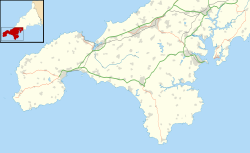Boscawen-Un
 The stone circle in 2011 | |
| Location | Cornwall |
|---|---|
| Coordinates | 50°05′23″N 5°37′08″W / 50.08978°N 5.618847°W |
| Type | Stone circle |
| History | |
| Periods | Neolithic / Bronze Age |
| Site notes | |
| Ownership | CASPN |
Boscawen-Ûn (grid reference SW412273) is a Bronze Age stone circle close to St Buryan in Cornwall, UK. It consists of nineteen upright stones in an ellipse with another, leaning, middle stone just south of the centre. There is a west-facing gap in the circle, which may have formed an entrance. The elliptical circle has diameters 24.9 and 21.9 metres (82 and 72 ft). It is located at grid reference SW412274.
The
Location
Boscawen-Un is in southwest Cornwall, in the Penwith district north of St Buryan, by the A30 road from Penzance to Land's End. Both the Merry Maidens stone circle and the two Pipers standing stones can be seen as can the sea.[3]
Boscawen-Un is a Cornish name, from the words bos (farmstead) and scawen (elder or elderberry tree). The suffix Un denotes an adjacent pasture. Therefore, the name translates as the pasture of the farmstead at the elderberry tree.[4]
Construction

The stone circle consists of a central

There is a wide gap in the west of the circle, which suggests the loss of stones. However this gap may represent, as with the nearby Merry Maidens, an entrance. The central stone is 2.7 m long, but because of its strong inclination to the north-east, the tip is only 2.0 m above the ground. It is claimed by some researchers that the central stone embodies the
History
The stone circle at Boscawen-Un was erected in the


See also
The site was the setting for the 1978 Doctor Who story "The Stones of Blood", though the episodes were actually filmed at the Rollright Stones.
Other prehistoric stone circles in the former Penwith district
- The Merry Maidens
- Tregeseal East – also known as the Tregeseal Dancing Stones
- Boskednan – also known as the Nine Maidens of Boskednan
References
- ^ "After 1000 years – Cornish Gorsedd ceremony revived at Penzance". The Adelaide Chronicle. 29 September 1928.
- ^ "Iolo Morganwg and the Romantic Tradition in Wales 1740–1918: Fuller Description - University of Wales".
- ^ Cornwall's Archaeological Heritage: Boscawen-ûn stone circle
- ^ a b c Peter Herring, (2000), Boscawen-Un – An Archaeological Assessment, Historic Environment Service, Cornwall County Council
- ^ Goskar, Tom (2015). "Neolithic Breton-Style Rock Art at Boscawen-ûn Stone Circle". Archived from the original on 23 November 2020. Retrieved 4 March 2020.
- ^ Carolyn Kennett, (2018) Celestial Stone Circles of West Cornwall: Reflections of the sky in an ancient landscape
- ^ Tregelles, George Fox (1893–94). "The Stone Circles of Cornwall". Reports and Transactions of the Penzance Natural History and Antiquarian Society: 147–170.
- ^ John Thomas Blight, (1865), Churches of West Cornwall with notes of antiquities of the district, Parker & Co., London
Further reading
- John Barnatt: Prehistoric Cornwall: The Ceremonial Monuments, Turnstone Press Limited 1982. ISBN 0-85500-129-1
- Ian McNeil Cooke: Standing Stones of the Land's End, Cornwall: Men-an-Tol Studio 1998, ISBN 0-9512371-9-5
- ISBN 0-300-08347-5.
- ISBN 0-7225-3599-6.
- ISBN 978-1973529125.
- ISBN 1-871060-31-1.
- ISBN 1-85058-462-1.
External links
- Boscawen Un stone circle site page on The Megalithic Portal
- Boscawen Un stone circle site page on The Modern Antiquarian

